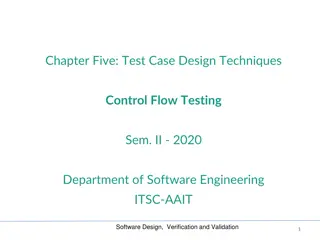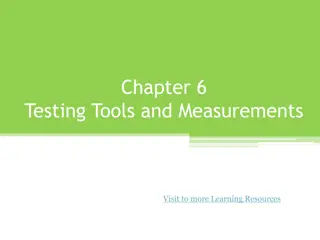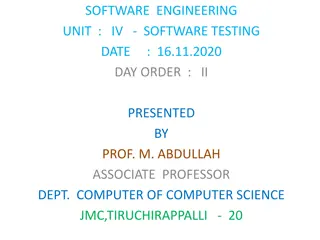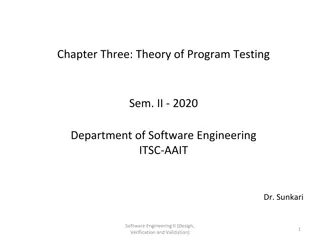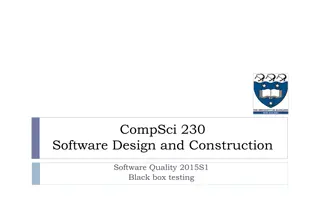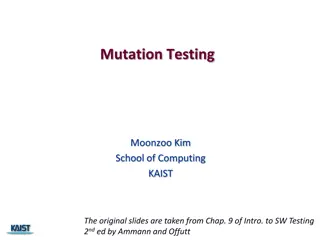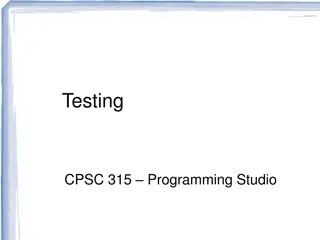Understanding Software Testing: Test Cases, Selection, and Execution
Software testing plays a crucial role in identifying and resolving issues within software products. Test cases, selection, and execution are fundamental aspects of the testing process. Test cases define conditions for testing software functionality, with a focus on repeatability and data specificity. Test selection involves identifying which test cases to execute, while test execution involves running these test cases to verify software behavior. Understanding the principles of writing effective test cases is essential, including considerations for domain knowledge, user perspectives, input scenarios, and expected results.
Download Presentation

Please find below an Image/Link to download the presentation.
The content on the website is provided AS IS for your information and personal use only. It may not be sold, licensed, or shared on other websites without obtaining consent from the author. Download presentation by click this link. If you encounter any issues during the download, it is possible that the publisher has removed the file from their server.
E N D
Presentation Transcript
Test Cases SE401: Software Quality Assurance and Testing
Outline Testing Test selection Writing test cases Test Execution 2
Testing There is a massive misunderstanding about testing: that it improves software. It doesn't! Weighing yourself doesn't reduce your weight Going to the doctor doesn't make you healthy. Those things help to identify problems that you might choose to resolve. Testing does too. The testing does not make the product better, even though it's part of a process that does make a product better. 3
Test cases A test case, is a set of conditions under which a tester will determine whether an application, software system or one of its features is working as it was originally established for it to do. Test cases are often referred to as test scripts, particularly when written when they are usually collected into test suites. A Test Case is a set of actions executed to verify a particular feature or functionality of your software application. 5
Test cases A test case is a description of a specific interaction that a tester will have in order to test a single behavior of the software. Test cases are very similar to use cases, in that they are step-by-step narratives which define a specific interaction between the user and the software. A typical test case is laid out in a table, and includes: A unique name and number A requirement which this test case is exercising Preconditions which describe the state of the software before the test case Steps that describe the specific steps which make up the interaction Expected Results which describe the expected state of the software after the test case is executed 6
Test cases Test cases must be repeatable. Good test cases are data-specific, and describe each interaction necessary to repeat the test exactly. 7
Writing test cases First you must understand the language fundamentals Sizes and limits of variables, platform specific information Second, you must understand the domain Read the requirements Think like a user what possible things do they want to do Think about possible mistakes ; i.e. Invalid input Think about impossible conditions or input What is the testing intended to prove? Correct operation gives correct behavior for correct input Robustness responds to incorrect or invalid input with proper results User acceptance typical user behavior Write down the test cases 8
Writing Good Test Cases Test Cases need to be simple and transparent Create Test Case with end user in mind Avoid test case repetition Do not Assume Stick to the Specification Documents. Ensure 100% Coverage Test Cases must be identifiable. Implement Testing Techniques It's not possible to check every possible condition in your software application Testing techniques help you select a few test cases with the maximum possibility of finding a defect 9
Writing Good Test Cases Boundary Value Analysis (BVA) testing of boundaries for specified range of values. Repeatable and self-standing The test case should generate the same results every time no matter who tests it 10
Writing a test case While drafting a test case do include the following information The description of what requirement is being tested Inputs and outputs or actions and expected results Test case must have an expected result. Verify the results are correct Testing Normal Conditions Testing Unexpected Conditions Bad (Illegal) Input Values Boundary Conditions 11
Writing test cases Cover all possible valid input Try multiple sets of values, not just one set of values Permutations of values Check boundary conditions Check for off-by-one conditions Check invalid input Illegal sets of value Illegal input Impossible conditions Totally bad input Text vs. Numbers, etc. 12
Writing test cases Beware of problems with comparisons How to compare two floating numbers Never do the following: float a, b; . . . if (a == b) Is it 4.0000000 or 3.9999999 or 4.0000001 ? What is your limit of accuracy? In object oriented languages make sure whether you are comparing the contents of an object or the reference to an object String a = Hello world!\n String b = Hello world!\n if ( a == b ) vs. if ( a.equals(b) ) 13
Writing test cases Let s consider the triangle example Cover all possible valid input all three possible conditions: equilateral, isosceles, scalene Try multiple sets of values, not just one set of values Permutations of values {3,4,5}, {4,3,5}, {5,4,3} Check boundary conditions Check for off-by-one conditions: 0, MAX_INT Check invalid input Illegal sets of value Wrong format: not integer Negative numbers Illegal input Impossible conditions: {2,3,8}, {2,3,5} {definition of a triangle} Totally bad input Text vs. Numbers, etc. 14
Writing test cases Let s consider the triangle example How to test the code? Have the code read from the standard input java Triangle < testcases.txt or, java Triangle 2 3 3 3 4 5 Have the output print to standard output. java Triangle > results.txt Combine the two and we have: java Triangle <testcases.txt >results.txt This assumes we have the code read three numbers on the line, or have the code read three numbers whether they are on one line or more. 15
Tips for testing You cannot test every possible input, parameter value, etc. So you must think of a limited set of tests likely to expose bugs. Think about boundary cases positive; zero; negative numbers; infinity; very small right at the edge of an array or collection's size (plus or minus one) Think about empty cases and error cases 0, -1, null; an empty list or array test behavior in combination maybe add usually works, but fails after you call remove make multiple calls; maybe size fails the second time only 16
Test cases Why we write test cases? The basic objective of writing test cases is to validate the testing coverage of the application. Keep in mind while writing test cases that all your test cases should be simple and easy to understand. For any application basically you will cover all the types of test cases including functional, negative and boundary value test cases. 19
Trustworthy tests Test one thing at a time per test method. 10 small tests are much better than 1 test 10x as large. Each test method should have few (likely 1) assert statements. If you assert many things, the first that fails stops the test. You won't know whether a later assertion would have also failed. Tests should avoid logic. minimize if/else, loops, switch, etc. avoid try/catch If it's supposed to throw, use expected= ... if not, let JUnit catch it. Torture tests are okay, but only in addition to simple tests. 20
Test Execution The software testers begin executing the test plan after the developers deliver the alpha build, or a build that they feel is feature complete. The alpha should be of high quality the developers should feel that it is ready for release, and as good as they can get it. There are typically several iterations of test execution. First, focus on new functionality Then, regression test to make sure that a change to one area of the software has not caused any other part of the software Regression testing usually involves executing all test cases which have previously been executed There are typically at least two regression tests for any software project 21
Test Execution When is testing complete? No defects found Or defects meet acceptance criteria outlined in test plan 22
Automating Test Execution Designing test cases and test suites is creative Like any design activity: A demanding intellectual activity, requiring human judgment Executing test cases should be automatic Design once, execute many times Test automation separates the creative human process from the mechanical process of test execution 23
From Test Case Specifications to Test Cases Test design often yields test case specifications, rather than concrete data Ex: a large positive number , not 420023 Ex: a sorted sequence, length > 2 , not Alpha, Beta, Chi, Omega Other details for execution may be omitted Generation creates concrete, executable test cases from test case specifications 24
Scaffolding Code produced to support development activities (especially testing) Not part of the product as seen by the end user May be temporary (like scaffolding in construction of buildings) Includes Test harnesses, drivers, and stubs Example: JUnit test harness Eclipse IDE, scaffolding, JUnit built in 25
Scaffolding ... Test driver A main program for running a test May be produced before a real main program Provides more control than the real main program To drive program under test through test cases Test stubs Substitute for called functions/methods/objects Test harness Substitutes for other parts of the deployed environment Ex: Software simulation of a hardware device 26
Stubs 27
Drivers 28
Generic or Specific? How general should scaffolding be? We could build a driver and stubs for each test case ... or at least factor out some common code of the driver and test management (e.g., JUnit) ... or further factor out some common support code, to drive a large number of test cases from data (as in DDSteps) ... or further, generate the data automatically from a more abstract model (e.g., network traffic model) A question of costs and re-use Just as for other kinds of software 29
Oracles Did this test case succeed, or fail? No use running 10,000 test cases automatically if the results must be checked by hand! Range of specific to general, again ex. JUnit: Specific oracle ( assert ) coded by hand in each test case Typical approach: comparison-based oracle with predicted output value Not the only approach! 30
Comparison-based oracle With a comparison-based oracle, we need predicted output for each input Oracle compares actual to predicted output, and reports failure if they differ Fine for a small number of hand-generated test cases E.g., for hand-written JUnit test cases 31 of 89
Self-Checking Code as Oracle An oracle can also be written as self-checks Often possible to judge correctness without predicting results Advantages and limits: Usable with large, automatically generated test suites, but often only a partial check e.g., structural invariants of data structures recognize many or most failures, but not all 32 of 89
Capture and Replay Sometimes there is no alternative to human input and observation Even if we separate testing program functionality from GUI, some testing of the GUI is required We can at least cut repetition of human testing Capture a manually run test case, replay it automatically with a comparison-based test oracle: behavior same as previously accepted behavior reusable only until a program change invalidates it lifetime depends on abstraction level of input and output 33
Defect Tracking The defect tracking system records and tracks defects. It routes each defect between testers, developers, the project manager and others, following a workflow designed to ensure that the defect is verified and repaired. 34
Smoke Tests A smoke test is a subset of the test cases that is typically representative of the overall test plan. Smoke tests are good for verifying proper deployment or other non invasive changes. They are also useful for verifying a build is ready to send to test. Smoke tests are not substitute for actual functional testing. 35
Summary Goal: Separate creative task of test design from mechanical task of test execution Enable generation and execution of large test suites Re-execute test suites frequently (e.g., nightly or after each program change) Scaffolding: Code to support development and testing Test drivers, stubs, harness, including oracles Ranging from individual, hand-written test case drivers to automatic generation and testing of large test suites Capture/replay where human interaction is required 36


